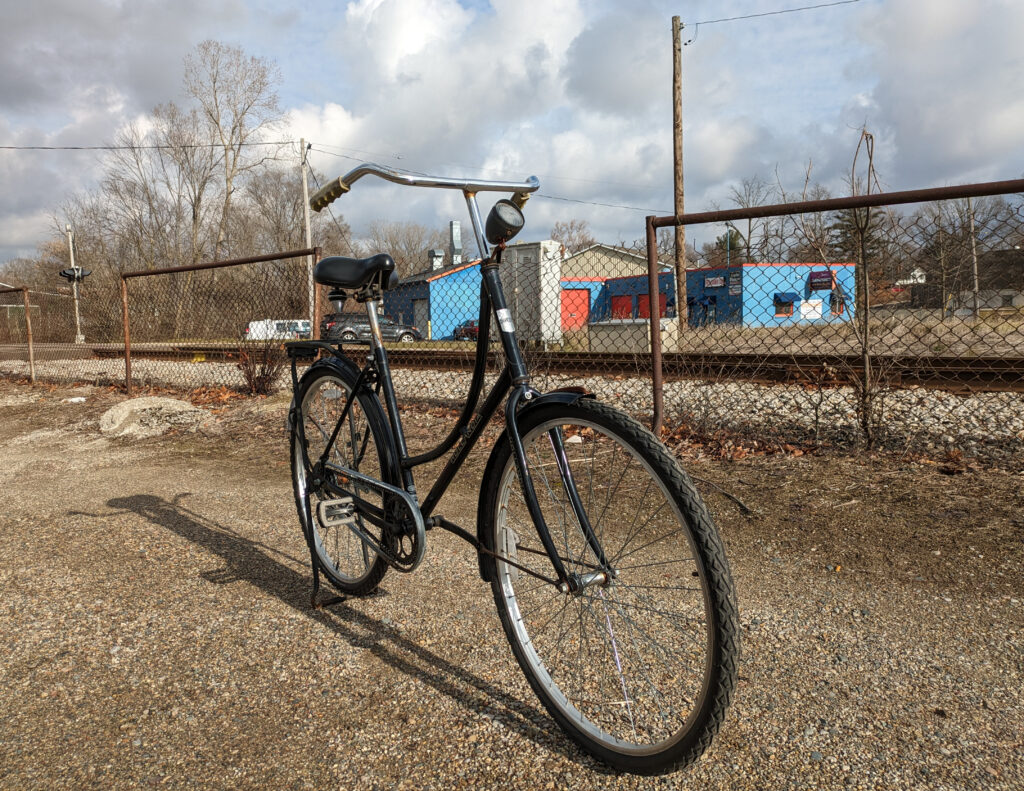
Like my 1988 Raleigh Technium, this bike is one which came through the bike shop I was working at as a donation. I had been looking for an Omafiets, or Grandma-bike for a while, and even had hatched a plan to go to Amsterdam and buy an o.g. one in-person, but when my boss only wanted $65 for this one as-is I had to buy it.
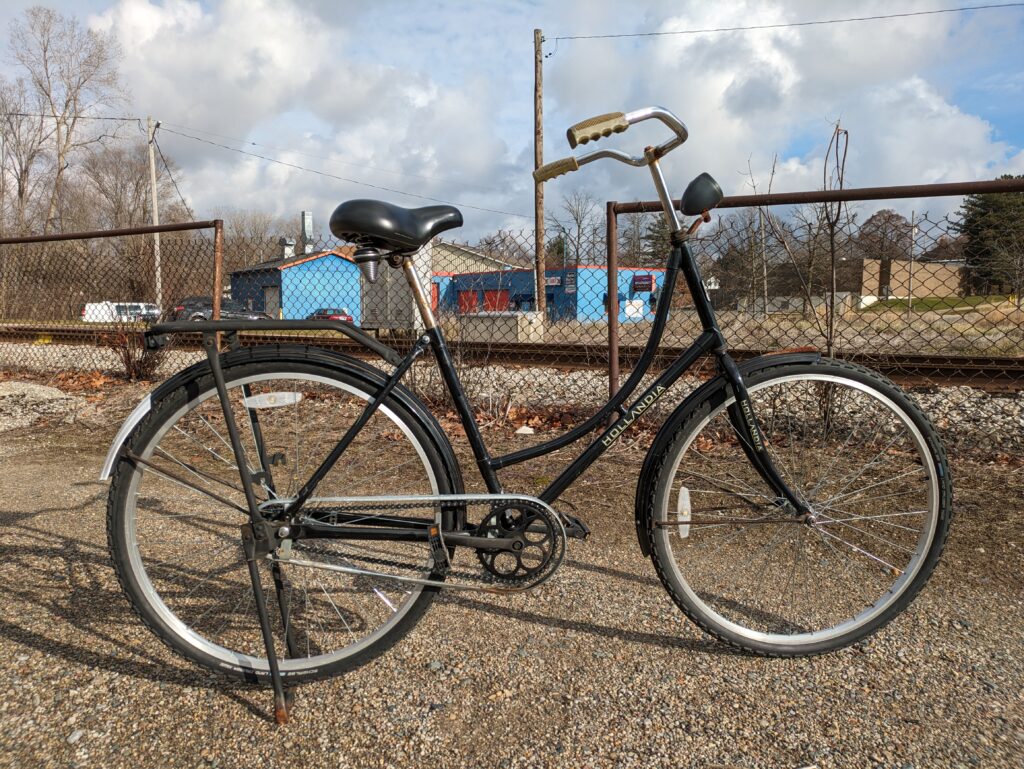
The Omafiets is the quintessential Dutch-style city bike; indeed, if you ask anybody from the Netherlands to picture a standard bicycle this is likely what they would imagine. Technically called a ‘roadster’ bicycle, this is a bike built purely for utility. While traditionally thought of as a ‘ladies bike’, these days the Omafiets is more correctly referred through as a ‘step-through’ design and is a style used by people of all ages and genders. The bikes are simple, with steel frames, limited gears, weather-resistant coaster or drum brakes, fenders, and a rear luggage rack for utility. Many also include chain and skirt guards to keep the rider’s clothes clean.
The Hollandia bike is interesting in that I could find very little information about the bike brand online. There is a website for Hollandia bikes which claims that Hollandia started building bicycles in Amsterdam in 1886, but the ‘about me’ of the site says very little about the modern history of the brand… and if you go to the ‘contact us’ page the contact email address and phone number are Hungarian. I also searched to see if I could find any reference to these bikes being sold by retailers in the Netherlands or in Hungary, and I did find one Dutch site which had a different Hollandia model for sale, but overall there just isn’t very much information about this brand online.
My particular Hollandia bike has stickers which say ‘Manufactured by Cycle Force Group’ and ‘Made in China’, and because this is all in English I figured that my bike was originally sold in the U.S., but I still wasn’t able to find much information about this specific bike until I came across this blog. According to the author, Hollandia bikes were designed by the legitimate importer Cycle Force Group, made in China, and started being sold through Walmart around 2011. The blog post shows the ‘Opafiets’ model, which is the diamond-frame version of what looks like the same bike I have, and at the time it was sold for $249 – equivalent to about $337 today.
I then searched the internet again and realized that as of December 2023 this bike-or at least a very similar model- is actually still being sold at Walmart for $450. I don’t know if the Hollandia bikes being sold at Walmart even have anything to do with the dutch Hollandia website I found, but at least I figured out where this bike was likely originally purposed. Dutch-style bikes usually cost a lot more than $450 in the U.S., but this price is pretty comparable to what these sorts of bikes cost in the Netherlands… so the question becomes, how does this bike really compare to a true Dutch bike, and is it any good? Before we get into that, let’s take a look at this bike’s specifications and discuss some of its details:
Frame: High-Tensile Steel
Fork: High-Tensile Steel
Crankset: Generic Steel
Rear Sprocket: 18-Tooth
Brake: Rear Coaster
Handlebars: Generic Steel Cruiser Style
Stem: Extra long quill stem, integrated with handlebars
Grips: White Plastic
Rims: Generic Aluminum, 28″ (700c)
Tires: Schwalbe Land Cruiser 700 x 40c
Saddle: Selle Royale Wide-Profile Utility Saddle w/ Springs
Seatpost: Steel
Pedals: Black Flat Plastic
Other: Integrated Kickstand, Fenders, Rear Utility Rack
Frame
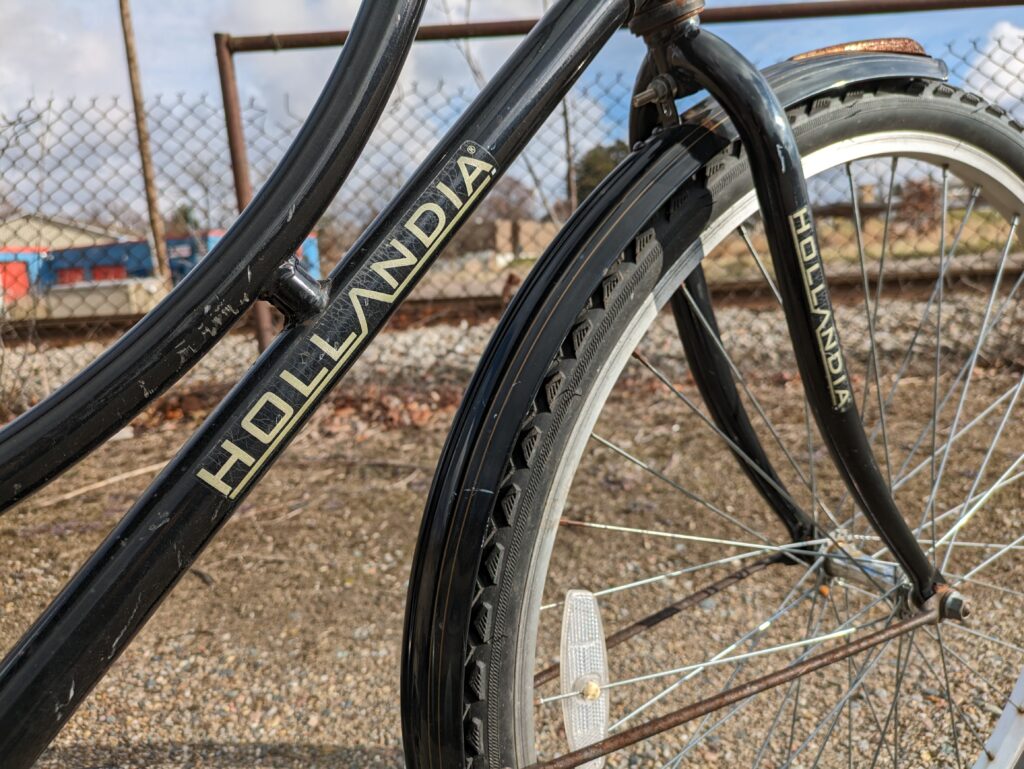
This bike frame is a basic step-through design made of high-tensile steel. The bike is a classic roadster which includes a rack, fenders, and an integrated kickstand, and it also originally came with a chain guard, wheel skirt, and battery-operated lights. It is painted black and overall it is very similar, if not identical to the basic Omafiets-style bike you can find all over the Netherlands.
The riding position is very upright, and there is a lot of adjustability in both the height of the saddle and the height of the stem, so this bike is suitable for people of many different heights. The relaxed geometry also means that this bike can be ridden while wearing almost any clothes, and the chain guard and wheel skirt that were originally specced would also have helped keep flowy garments out of the drivetrain.
Drivetrain
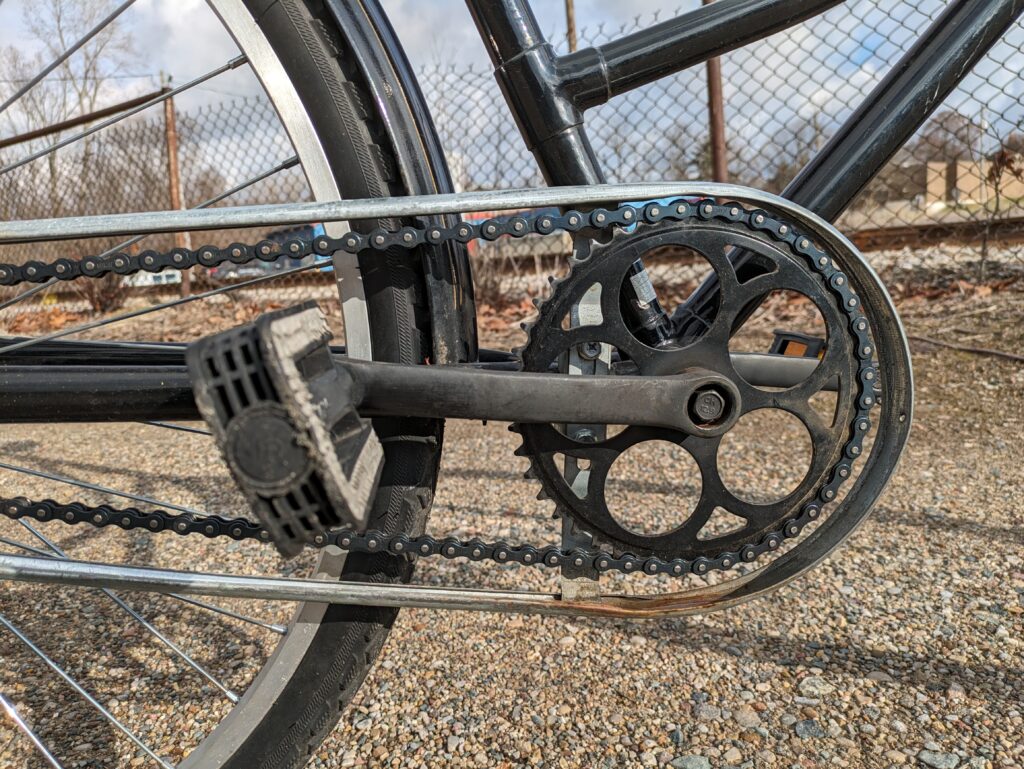
This is a single-speed bike with a 44-tooth chainring and an 18-tooth rear sprocket. Combined with the 700x40c tires this makes for 68 gear-inches overall. This is very typical for single-speed roadsters, but in my opinion this gearing is way too high for normal utility use on flat pavement or mild hills. Fixies and urban singlespeed bikes are also geared similarly, but they are much lighter with a more aggressive riding position which allows those types of bikes to maintain higher speeds more easily. On this Omafiets, the 68 gear-inch ratio is okay on the flat, but it is a real struggle to get up anything more than a short, shallow hill, and I personally would prefer gearing that is significantly lower for utility use. Overall, the relaxed riding position and heavy gearing mean that this is a bike you lazily pedal at a low cadence and slowly cruise around on rather than something you use if you want to go long distances or get anywhere quickly.
Brakes

This bike did have a front caliper brake when I got it but it was the type found on old bikes or cheap department store bikes which are not very effective and hard to adjust so I removed it. The rear brake is a coaster brake, something that is rare on American-style bikes, and while it is not particularly powerful, it is virtually maintenance-free and more than adequate for something like this which is mainly designed for low-speed on-road use. Overall, I like the simplicity of this setup quite a lot.
Wheels & Tires
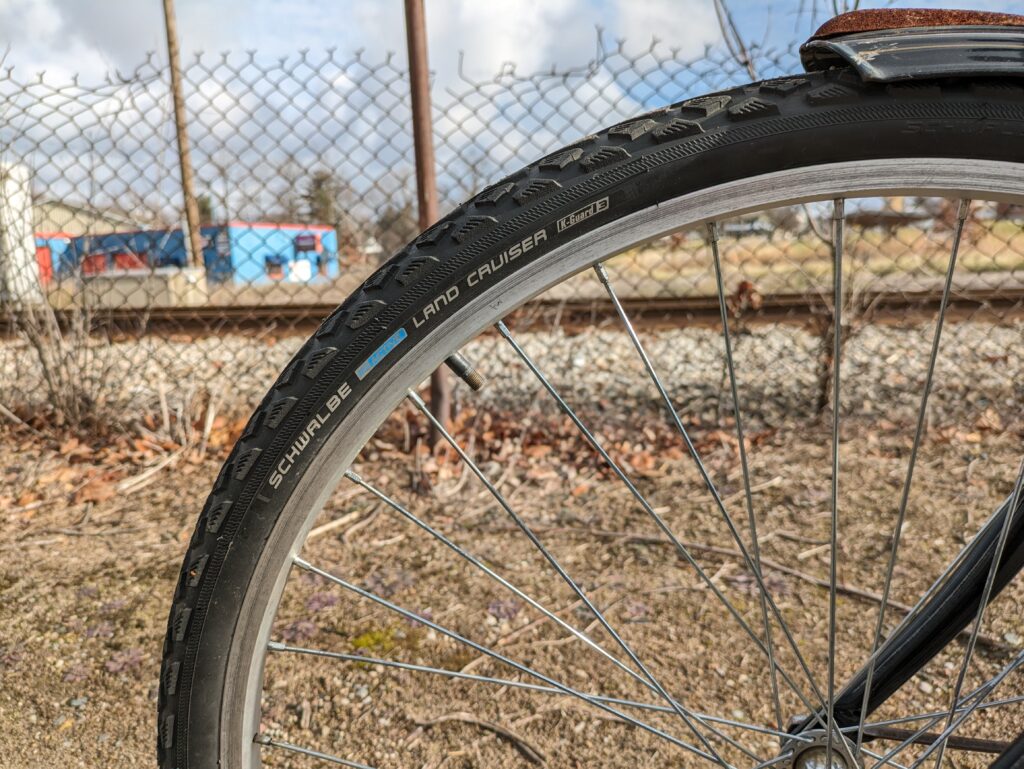
Many low-end Dutch bikes come with steel wheels, but these are aluminum, and while they are unbranded they are rather nice and more than adequate for this application. The original tires were completely worn out when I got the bike, but I installed a set of Schwalbe Land Cruiser 700 x 40c tires I had laying around which seem to suit this style of bike very well. They are heavy utility-style tires, but there is no doubt that they are durable and flat-resistant.
Contact Points & Accessories
The contact points on this bike are mostly generic: the pedals are basic plastic flats, and the grips are made of a hard polymer material. The original saddle was broken when I got the bike, so I replaced it with a wide-profile Selle Royale. This saddle is heavy and ugly, but its wide profile works well for the upright riding position demanded by this bicycle.
Restoration
When I got this bike it was in pretty rough condition, but I always intended it to be a utilitarian bike I could leave outside and use to putz around the small town I live in. Therefore when I fixed it up it I focused more on just getting it working than making it perfect.
The main problem with this bike was that the bottom bracket was completely seized, but I did eventually manage to remove it from the frame and replace it. Next, I removed the front brake because it was so cheaply made and difficult to adjust that I just didn’t think it was worth fixing. I also didn’t think it was necessary to have two brakes on a low-speed utility bike like this. Then I trued the wheels and adjusted the hubs, but I didn’t bother regreasing the bearings because they felt good enough as they were, and I didn’t want to have to deal with disassembling the coaster brake. After Installing some Schwalbe Land Cruiser tires, I cleaned up the frame, reinstalled the wheels, and installed a new chain.
There is a lot of hardware attached to the rear triangle of this bike including a rack, fender, and kickstand, and it was pretty difficult to get the wheel installed and everything lined up properly. I did try to reinstall the original chain guard, but it was ripped and in pretty rough shape overall, so I ended up just leaving the guard’s frame in place, which still provides a little protection from the chain. I also ended up removing the remnants of the wheel skirt, because half of it was already messing, and the other half was rubbing against the tire. Finally, I finished off the build with a Selle Royale saddle I had.
Discussion & Ride Quality
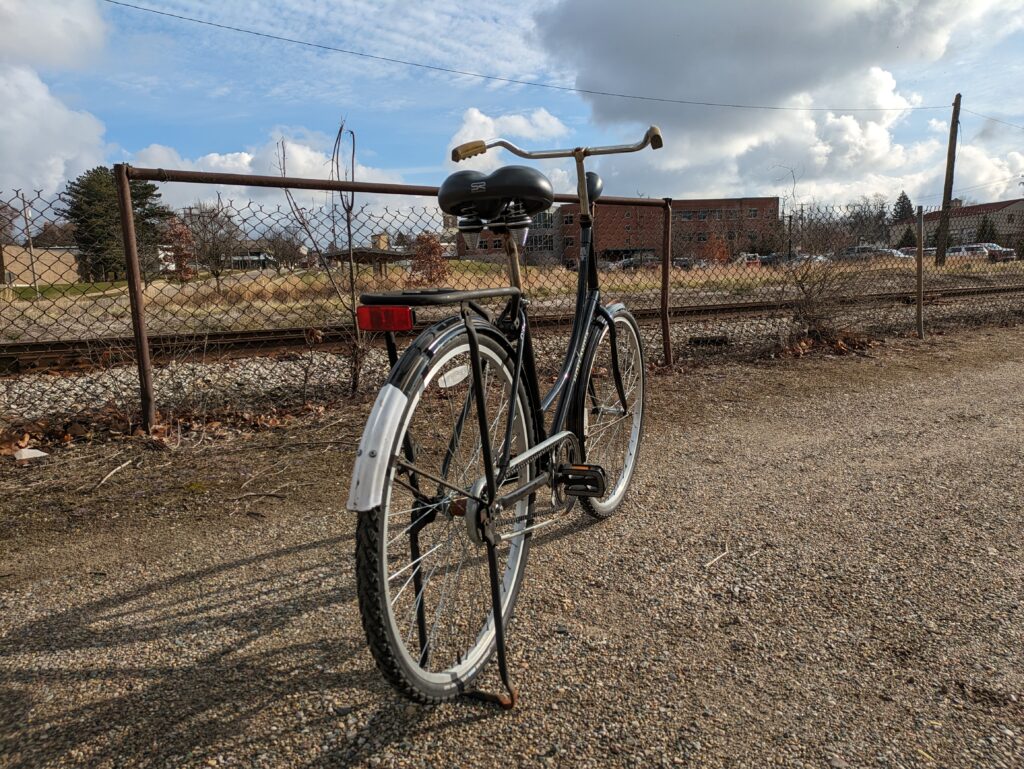
Even though it is a little unclear who actually built this bike and whether or not the Hollandia brand sold at Walmart is related to the original Dutch Hollandia brand (which in itself is a bit of a mystery brand), I think that this bike is a surprisingly good homage to the original Omafiets. I lived in the Netherlands for two years and have spent quite a bit of time in Amsterdam since then, and it is pretty much identical to the lower-end Omafietsen you see being used in the Netherlands. Yes it’s made in China but but my understanding is that a lot of the more generic bikes sold over there are also either made in China or assembled in eastern Europe of Chinese components, so not a lot of difference in terms of the components the bike is made of either.
As I already mentioned, the riding position of this bike is very upright, which means that this bike can by used by practically anyone wearing almost any type of clothing. The high-tensile steel frame is virtually bombproof, but I always find these types of bikes to feel quite ‘flexy’, and this one is no exception. What I mean is that this bike flexes side to side quite a bit under pedaling, especially when it is loaded. This isn’t necessarily a bad thing and it certainly isn’t a strength issue, but it does give the bike a unique ‘soft’ ride quality which takes some time to get used to. Overall it feels exactly like the similar-styled bikes I have ridden in the Netherlands.
There are no gears on this bike, which is great for simplicity and durability, but I do think that the gearing is a little too high. The brakes on this bike are not particularly powerful, but they are adequate for low-speed use, and overall this bike works fine for tooling around town, especially if the terrain is flat. The rack, fenders, and kickstand add to the utility of the bike, and its simplicity means that this bike is easy to maintain and that there is not a lot to go wrong with it. Overall I love keeping it locked up outside of my apartment as something to jump on and be able to go with whenever I feel like it.